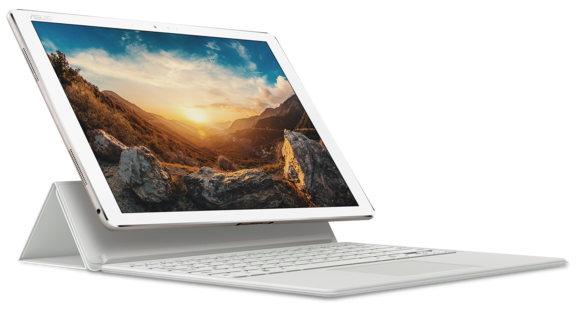On Monday May 30th 2016, ASUS has issued a press release, which highlights the company’s presence at this year’s Computex, held at the Taipei World Trade Center, Nangang Exhibition Hall, thought May 3rd.

Within the same press release, Asus has also officially unveiled the next generation of Transformer devices, aimed to directly compete with Microsoft’s Surface line of products. Asus Transformer 3, and 3 Pro are among the main products recently introduced, with specs that, as previously mentioned, do pitch the Transformer 3 directly against the Surface Pro 4.
Touchscreen and Stylus
The Transformer 3 and Surface Pro 4 are very similar in screen size, with the former sporting a 12.6 inch touchscreen display with a resolution of 2880 by 1920 (275ppi), and the latter measuring 12.3 inches, with a resolution of 2736 x 1824 (267ppi).
Both devices come with a stylus, and both accessories offer 1024 pressure levels, which puts both ultraportables on par with each other’s responsiveness and capability in regard to drawing and writing.
Processing power
The main CPU powering the Surface Pro 4 can be chosen among three 6th generation Intel Core options: m3, for entry-level performance, i5, capable of standard workloads, and i7, for more advanced performance.
The Asus Transformer 3 Pro, on the other hand, is powered by an Intel Core i7, with the Transformer 3 offering an entry level alternative.
In a sense, Asus is taking a page from Microsoft’s former strategy, of offering multiple versions of a device, rather than one tablet that can fit multiple purposes, depending on the choice of processor.
In regard to integrated graphic performance, ASUS’ press release is seemingly devoid of information on the matter, with that said, there seems to be an emphases on the ASUS ROG XG Station, which is a Transformer 3 compatible dock which features an external graphic processing unit capable of delivering desktop-class graphic performance to ASUS Transformer 3 tablet PCs.
The ROG XG Station would tip the ball right into the net for ASUS, with a mobile dock that would have virtually no rivals in the world of ultraportables, unless Microsoft has something in store for the last quarter of 2016. With that said, by leaving much of the graphic and audio capabilities of the Transformer 3 Pro up to an external, and possibly expensive, accessory, a question arises on whether consumers will be willing to make the extra investment.
Memory and storage
Both the Transformer 3 Pro and the Surface Pro 4, feature the same memory and storage options, with support for up to 1TB SSD, and 16GB or RAM.
Connectivity and ports
The Surface Pro 4 and the ASUS Transformer 3 Pro offer a fairly comprehensive range of expansion ports, with the former featuring USB 3.0, Mini Display Port, Cover Port, and Surface Connect, and the latter also supporting USB 3.0 and Thunderbolt 3, as well as HDMI, VGA and RJ-45 LAN. With that said, the Transformer 3 Pro offers a built-in USB Type-C port as well, which opens the device to USB 3.1 peripherals.
While USB 3.1 support is still limited, it is growing, and new devices are expected to support USB Type-C ports at a much faster rate than last year.
Aside from the extra USB 3.1 connector, the Transformer 3 Pro also offers a 3-in-1 SD card reader, while the Surface Pro 4 features only a microSD slot.
Camera and Windows Hello
The Transformer 3 Pro is one of the first device to fully support Windows Hello facial recognition, through the integrated camera, while the Surface Pro 4 relies on the fingerprint sensor integrated in the updated Type Cover.
The Transformer 3 Pr also features a 13MP front-facing camera, while the Surface Pro 4 has a built-in 8MP front-facing camera, and a 5MP rear-facing HD camera which also supports Windows Hello. With that said, neither cameras have Intel RealSense 3D technology, which makes them both less effective in respect to a more solid biometric method, like the fingerprint sensor, or Intel’s dedicated hardware.
Verdict
Both ASUS Transformer 3 Pro and the Surface Pro 4 are excellent ultraportable devices, with nearly identical specs. With that said, there are some considerations to make in regard to the type of user to which each device caters.
The Microsoft Surface Pro 4 is a device that has everything out of the box, from solid integrated graphic hardware, to respectable multimedia features, while on the other hand, the Transformer 3 Pro appears to rely on the ROG XG Station, in order to get a boost in performance and features, which is an extra expense that consumers will have to take into account.
The primary reason one could consider the purchase of an ROG XG alongside a Transformer 3 Pro, is gaming, as the dock provides for both advanced GPU capabilities, and 5.1 Surround sound support, which means that if you are a gamer, the Transformer 3 Pro is probably a better choice, depending on price.
On the other hand, for those looking for a computing device to use at work, or in school, the Surface Pro 4 offers a great experience right out of the box.